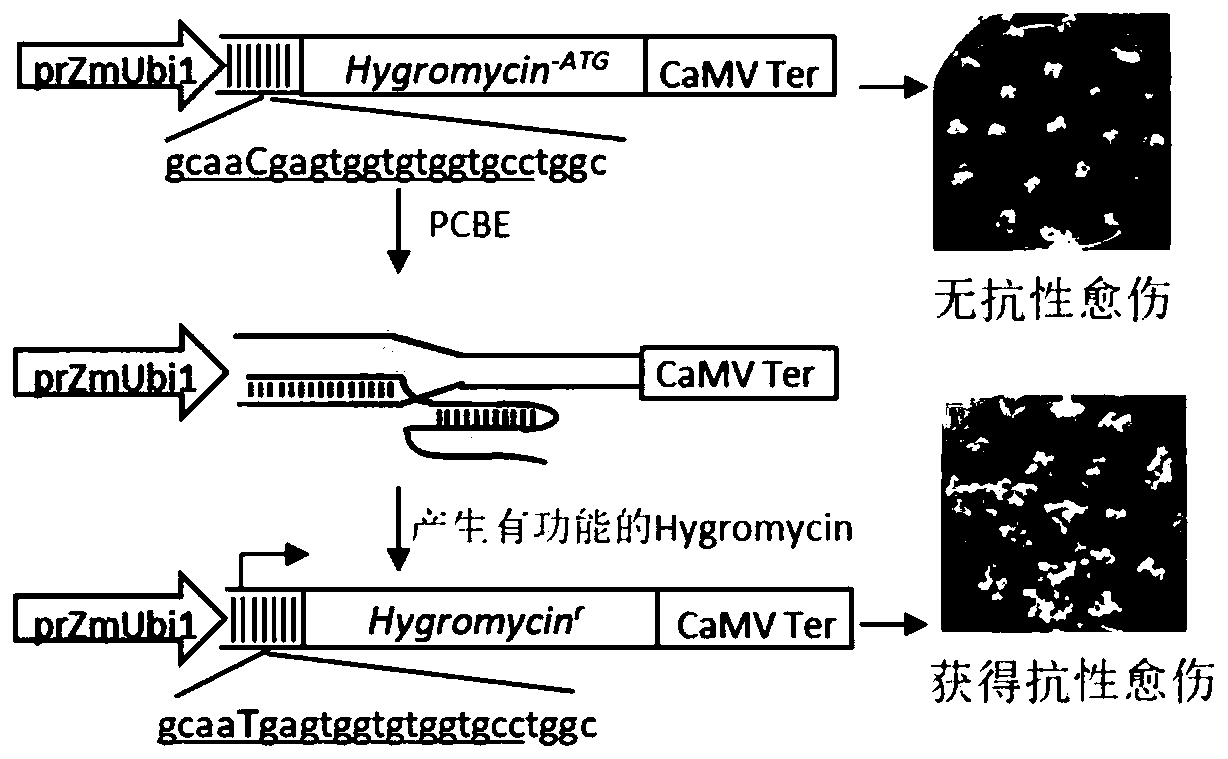Cell enrichment technology with C.T base substitution using inactive screening agent resistance gene as reporting system and application of technology
A technology of resistance gene and screening agent, applied in genetic engineering, recombinant DNA technology, introduction of foreign genetic material using vectors, etc.
- Summary
- Abstract
- Description
- Claims
- Application Information
AI Technical Summary
Problems solved by technology
Method used
Image
Examples
Embodiment 1
[0204] Example 1, Establishment of Cell Enrichment Technology for C T Base Substitution
[0205] 1. Establishment of cell enrichment technology carrier for C T base substitution
[0206] The common technology (non-cell enrichment technology) carrier of Cas9 nuclease, cytosine deaminase and UGI-mediated C T base replacement was named sgRNA-GT. Taking the Cas9 nuclease as SpCas9n and the cytosine deaminase as PmCDA1 as an example: the structure diagram of the sgRNA-GT vector is as follows figure 1 shown.
[0207] The cell enrichment technology carrier of Cas9 nuclease, cytosine deaminase and UGI-mediated C T base replacement was named sgRNA -ATG -Hyg -ATG / sgRNA-GT. Take the Cas9 nuclease as SpCas9n and the cytosine deaminase as PmCDA1 as an example: sgRNA -ATG -Hyg -ATG Schematic diagram of the structure of the / sgRNA-GT vector figure 2 shown.
[0208] The cell-free enrichment technology vector contains the complete selection agent resistance gene. The cell enrichmen...
Embodiment 2
[0214] Example 2, Construction of Cas9n&PmCDA1&UGI-mediated cell enrichment technology vector and its application in rice genome editing
[0215] 1. Construction of recombinant expression vector
[0216] The recombinant expression vector in this example is the non-cell enrichment technology carrier sgRNA-GT of Cas9n&PmCDA1&UGI (PCBE) mediated C T base substitution and the cell enrichment of Cas9n&PmCDA1&UGI (PCBE) mediated C T base substitution Technical carrier sgRNA -ATG -Hyg -ATG / sgRNA-GT. Each vector is a circular plasmid. The structural diagrams of the components of the two recombinant expression vectors are as follows: figure 1 and figure 2 shown.
[0217] According to the different target sequences contained, each recombinant expression vector is divided into two types, and there are four recombinant expression vectors as follows: sgRNA -ATG -Hyg -ATG / sgRNA-GT-1 recombinant expression vector, sgRNA -ATG -Hyg -ATG / sgRNA-GT-2 recombinant expression vector, ...
Embodiment 3
[0250] Example 3. Construction of HypaCas9n&PmCDA1&UGI-mediated cell enrichment technology vector and its application in genome editing of rice T0 seedlings
[0251] 1. Construction of recombinant expression vector
[0252] The recombinant expression vector in this example is a non-cell enrichment technology carrier (named HypaCas9n-sgRNA-GT) mediated by HypaCas9n&PmCDA1&UGI (HypaCas9-PCBE) mediated C T base replacement and HypaCas9n&PmCDA1&UGI (HypaCas9-PCBE) mediated Cell enrichment technology carrier (named sgRNA -ATG -Hyg -ATG / HypaCas9n-sgRNA-GT). Each vector is a circular plasmid. The structural diagrams of the components of the two recombinant expression vectors are as follows: Figure 7 shown. The main structure of the carrier is similar to that of Cas9n&PmCDA1&UGI-mediated non-cell enrichment technology carrier and cell enrichment technology carrier, the only difference is that HypaCas9n is used instead of SpCas9n. The working principle of HypaCas9n&PmCDA1&UGI-m...
PUM
 Login to View More
Login to View More Abstract
Description
Claims
Application Information
 Login to View More
Login to View More - R&D
- Intellectual Property
- Life Sciences
- Materials
- Tech Scout
- Unparalleled Data Quality
- Higher Quality Content
- 60% Fewer Hallucinations
Browse by: Latest US Patents, China's latest patents, Technical Efficacy Thesaurus, Application Domain, Technology Topic, Popular Technical Reports.
© 2025 PatSnap. All rights reserved.Legal|Privacy policy|Modern Slavery Act Transparency Statement|Sitemap|About US| Contact US: help@patsnap.com



